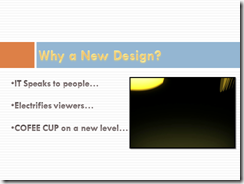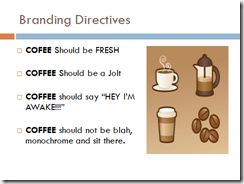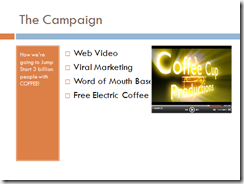I had a request to give people some ideas on how to demo to clients video stuff on a shoe string. Now, that’s kind of been a theme for the last few blogs so I’m guessing that “shoe string” means that a lot of people out there are looking to start small businesses on the side to help pay some bills. :-) A wise choice in this economy, and it’s always a good one.
Years ago I had my own business and I’ll never forget how hard it was to get clients to sit down and listen to your pitch. What I found is that you keep it short and sweet. Bullet points. And when it comes to looking like a professional outfit and the use of Bullet Points … PowerPoint is your buddy.
So first – understand that it doesn’t matter how good your presentation is – if there’s no facts. The one I’m showing here – has no real facts. Just flashy looks that I pulled together in about an hour or so, using existing work. So – first know what makes your product a good buy. You need to be able to show your customers how it’s going to benefit them.
 Since the request was for a video business – let’s look at what you can do for them. Video isn’t just about making movies – it’s about making a business look good. Start with their brand – and understand it. As a video company you have the ability to bring a brand to the next level. Make a nice quality demo reel – and make sure it includes their logo. Keep it short – 15 to 60 seconds – no more. You’re going to give them a taste – not a meal.
Since the request was for a video business – let’s look at what you can do for them. Video isn’t just about making movies – it’s about making a business look good. Start with their brand – and understand it. As a video company you have the ability to bring a brand to the next level. Make a nice quality demo reel – and make sure it includes their logo. Keep it short – 15 to 60 seconds – no more. You’re going to give them a taste – not a meal.
Begin with your presentation slide – which just has their name on it, and the ad campaign or purpose of the presentation.
Next – open with that 15 Second clip. Let them see it – make it big. Since you can put the Video right into the PowerPoint – yes, it allows you to put the video on a slide. Do that with whatever logo, text or other info you want.
You’ll probably want to go back to this slide from time to time after the presentation so they can see it for themselves. And don’t be afraid to say – this is what you came up with on your own, you’d really want to tailor this to their ideas and expectations. In fact – ask for those suggestions directly, and make sure you take notes when they speak but keep the conversation going. You need them to become involved in the production, even though they aren’t yet.
Initial impressions from a client often give you a lot of valuable information. Even if they hate it. In some cases negative feedback is better than positive feedback. With negative feedback you can put together a list of what they want. With positive feedback it’s harder to get that list. This isn’t the time to let them bog you down though – show them how you came to those conclusions that this was a direction. Show them why they need your product. If you have numbers showing cost effectiveness, or increased views – or anything like that to support you – now is when you bring them up.
 So get those numbers or facts – and distill them down to the top 3-5 reasons. Memorize these. Include them in your verbal pitch. Show them you have some idea how their business currently can benefit and that you actually looked into their business?
So get those numbers or facts – and distill them down to the top 3-5 reasons. Memorize these. Include them in your verbal pitch. Show them you have some idea how their business currently can benefit and that you actually looked into their business?
How? How do you get this info… Well, by doing a bit of research on the internet. Almost every business has a web site – and if they don’t their competitors do. Find out all you can about their business, and find out what it is they make money off of – cars, houses, coffee houses, hotels – know their business enough to list 3-5 ways they can benefit from what you’re offering them.
This also helps by knowing that most small businesses  do not have… a brand. Branding is something big businesses talk about and small to medium businesses have but don’t know they have usually. So put up a slide that shows that you understand their brand. But make sure that you do. Are they a very small homey business? Well – then probably going with a very big uber clean steel and chrome look won’t work. But there is always something about a business that makes it that business. That’s their identity. Sometimes the problem is – they have no identity. So you need to provide them with one. Show them you understand where they’re coming from – and if possible where they want to go.
do not have… a brand. Branding is something big businesses talk about and small to medium businesses have but don’t know they have usually. So put up a slide that shows that you understand their brand. But make sure that you do. Are they a very small homey business? Well – then probably going with a very big uber clean steel and chrome look won’t work. But there is always something about a business that makes it that business. That’s their identity. Sometimes the problem is – they have no identity. So you need to provide them with one. Show them you understand where they’re coming from – and if possible where they want to go.
 Next… do a little footwork. Go out and ask people what they think – or get some statistics that prove your point. Show your customer that what you provide or how you provide what they currently have can work for them.
Next… do a little footwork. Go out and ask people what they think – or get some statistics that prove your point. Show your customer that what you provide or how you provide what they currently have can work for them.
By doing that footwork and research - you show that you actually did do the home work of trying to understand their business. Whatever you can get is helpful – just not too much. So use statistics, can use man-on-the-street interviews or surveys, you can do this many ways.
But don’t just say, “Hey I think your business needs…” – back it up. Show them you’re not alone in your thinking – and that you have a valid reason for it. Now – some business will tell you straight up that’s not the look, the feel, the way they want to do things.
If that’s not the direction the business wants – then dig in and find out what direction they DO want to go into. What do they think the challenges are? Where are their customers? Let them know you’d like to put something together to reflect that – that you’re really sincere about making sure you’re giving them the best you can – and making them look the best they can.
 Words are great. But back it up. A lot of times people have no idea how to use a product. So show them how. Give them an idea of how you see this being used. Web Videos, TV Commercials, Word of mouth – however you see the product being used… put together a game plan because a lot of small businesses don’t have an idea how, who, what or why. They just know they need something. You’re the professional – so give them the info they need. You’re not saying', “go do this…”, you’re just suggesting these as uses. The final decision is always up to the customer.
Words are great. But back it up. A lot of times people have no idea how to use a product. So show them how. Give them an idea of how you see this being used. Web Videos, TV Commercials, Word of mouth – however you see the product being used… put together a game plan because a lot of small businesses don’t have an idea how, who, what or why. They just know they need something. You’re the professional – so give them the info they need. You’re not saying', “go do this…”, you’re just suggesting these as uses. The final decision is always up to the customer.
It’s not a bad idea – to even have a demo set up. Maybe a web based player like this showing the demo you previewed….
If you have an alternate – or more – include a couple (no more than 3 if possible) to show other ways you can play it out and that you have the flexibility to really shine for them.
Like I say, keep it short – 15-60 second blips and only a few of them. I can almost 100% guarantee they will assume that your showing them the final product. Make sure they understand you’ve gone in a direction – and you want them to really help and direct you to the right direction for their business.
Sometimes they’ll suggest stuff that just… isn’t good. Find out out strongly they feel about this – see if you can compromise, but as a rule even if it’s not good… do it.
Because – and this is very hard for creative type people to understand sometimes… the customer is always right. Even when they’re wrong – the customer is always right.
Last but not least… always close with a way for them to ask for more information and give them a copy of the presentation.
I like to put all of this on a CD or a USB stick – with an Autorun file so it runs whenever it’s plugged in. To do this copy your completed PowerPoint and compile it using the PowerPoint viewer so in case they don’t have a copy of PowerPoint it will work. (Make sure you include all the videos you need on the USB.) Test it a few times on different machines to make sure it works… and you’re ready.
Now… one final point. If you’re like my friend Shelly (who asked for this) you may not have a big portfolio yet – and that is hard to over come. A good way I learned in my business when I was starting out, to get business was to offer to do it for free. Explain to them you’re starting out – you need a portfolio built, and you’re willing to do the job for free (or cost) so that you can include it in your portfolio of professional work.
Almost no business ever turns down free. So use them to build up your profile. You’d be surprised how many times I’d done work pro-bono that later they came back and asked for updates – or completely new work. Often they would show it off to other businesses – and generate work for you.
Hey … it’s worth a shot, and for a business like Shelly’s, her own effort is the biggest cost. Once you have done a “pro-bono” – a freebie. Never do them again unless it’s a charity. Remember, regardless of how it may seem somedays – you are a business.
You can download the PowerPoint Presentation above (although I’m not sure why you’d want to…) at:
PowerPoint Presentation for CoffeeCup







No comments:
Post a Comment